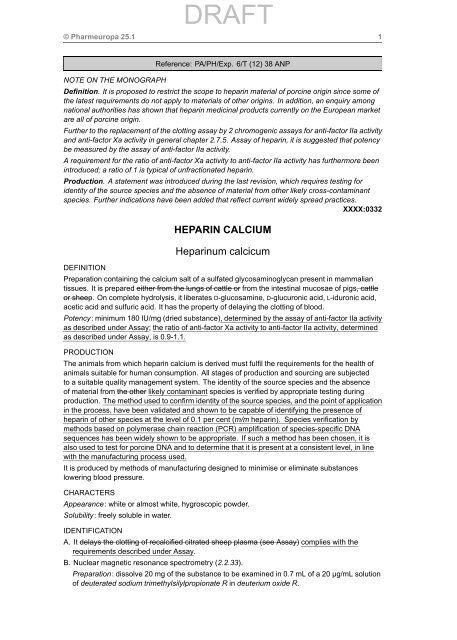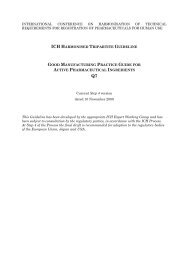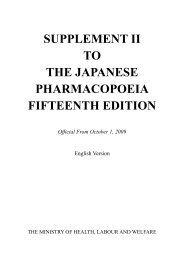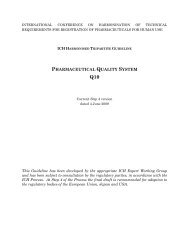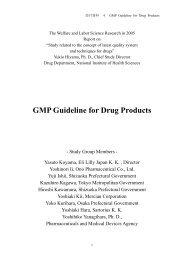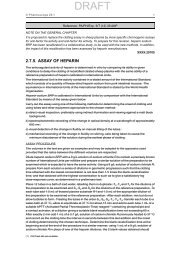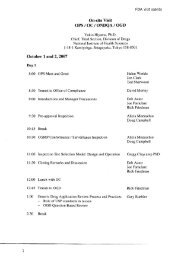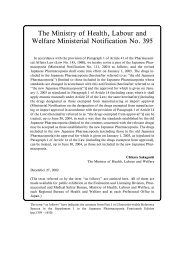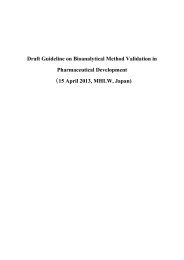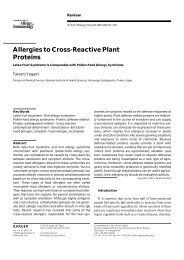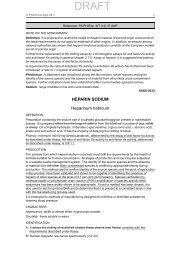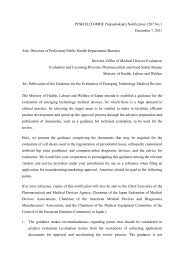HEPARIN CALCIUM Heparinum calcicum - NIHS
HEPARIN CALCIUM Heparinum calcicum - NIHS
HEPARIN CALCIUM Heparinum calcicum - NIHS
You also want an ePaper? Increase the reach of your titles
YUMPU automatically turns print PDFs into web optimized ePapers that Google loves.
DRAFT© Pharmeuropa 25.1 1Reference: PA/PH/Exp. 6/T (12) 38 ANPNOTE ON THE MONOGRAPHDefinition. It is proposed to restrict the scope to heparin material of porcine origin since some ofthe latest requirements do not apply to materials of other origins. In addition, an enquiry amongnational authorities has shown that heparin medicinal products currently on the European marketare all of porcine origin.Further to the replacement of the clotting assay by 2 chromogenic assays for anti-factor IIa activityand anti-factor Xa activity in general chapter 2.7.5. Assay of heparin, it is suggested that potencybe measured by the assay of anti-factor IIa activity.A requirement for the ratio of anti-factor Xa activity to anti-factor IIa activity has furthermore beenintroduced; a ratio of 1 is typical of unfractionated heparin.Production. A statement was introduced during the last revision, which requires testing foridentity of the source species and the absence of material from other likely cross-contaminantspecies. Further indications have been added that reflect current widely spread practices.XXXX:0332<strong>HEPARIN</strong> <strong>CALCIUM</strong><strong>Heparinum</strong> <strong>calcicum</strong>DEFINITIONPreparation containing the calcium salt of a sulfated glycosaminoglycan present in mammaliantissues. It is prepared either from the lungs of cattle or from the intestinal mucosae of pigs, cattleor sheep. On complete hydrolysis, it liberates D-glucosamine, D-glucuronic acid, L-iduronic acid,acetic acid and sulfuric acid. It has the property of delaying the clotting of blood.Potency: minimum 180 IU/mg (dried substance), determined by the assay of anti-factor IIa activityas described under Assay; the ratio of anti-factor Xa activity to anti-factor IIa activity, determinedas described under Assay, is 0.9-1.1.PRODUCTIONThe animals from which heparin calcium is derived must fulfil the requirements for the health ofanimals suitable for human consumption. All stages of production and sourcing are subjectedto a suitable quality management system. The identity of the source species and the absenceof material from the other likely contaminant speciesisverified by appropriate testing duringproduction. The method used to confirm identity of the source species, and the point of applicationin the process, have been validated and shown to be capable of identifying the presence ofheparin of other species at the level of 0.1 per cent (m/m heparin). Species verification bymethods based on polymerase chain reaction (PCR) amplification of species-specific DNAsequences has been widely shown to be appropriate. If such a method has been chosen, it isalso used to test for porcine DNA and to determine that it is present at a consistent level, in linewith the manufacturing process used.It is produced by methods of manufacturing designed to minimise or eliminate substanceslowering blood pressure.CHARACTERSAppearance: white or almost white, hygroscopic powder.Solubility: freely soluble in water.IDENTIFICATIONA. It delays the clotting of recalcified citrated sheep plasma (see Assay) complies with therequirements described under Assay.B. Nuclear magnetic resonance spectrometry (2.2.33).Preparation: dissolve 20 mg of the substance to be examined in 0.7 mL of a 20 µg/mL solutionof deuterated sodium trimethylsilylpropionate R in deuterium oxide R.
DRAFT© Pharmeuropa 25.1 3The following chromatogram is shown for information but will not be published in the EuropeanPharmacopoeia.1. dermatan sulfate + chondroitinsulfate2. heparin 3. over-sulfated chondroitinsulfateFigure 0332.-1. – Chromatogram for identification test C of heparin calcium: reference solution (c)(chromatogram obtained after subtraction of the blank)Injection: test solution (a) and reference solution (c).Relative retention with reference to heparin (retention time = about 26 min): dermatan sulfateand chondroitin sulfate = about 0.9; over-sulfated chondroitin sulfate = about 1.3.System suitability: reference solution (c):— peak-to-valley ratio: minimum 1.3, where H p= height above the baseline of the peak due todermatan sulfate + chondroitin sulfate and H v= height above the baseline of the lowest pointof the curve separating this peak from the peak due to heparin.Results: the principal peak in the chromatogram obtained with test solution (a) is similar inretention time and shape to the principal peak in the chromatogram obtained with referencesolution (c).D. It gives the reactions of calcium (2.3.1).TESTSAppearance of solution. The solution is clear (2.2.1) and not more intensely coloured thanintensity 5 of the range of reference solutions of the most appropriate colour (2.2.2, Method II).Dissolve a quantity equivalent to 50 000 IU in water R and dilute to 10 mL with the same solvent.pH (2.2.3):5.5to8.0.Dissolve 0.1 g in carbon dioxide-free water R and dilute to 10 mL with the same solvent.Nucleotidic impurities. Dissolve40mgin10mLofwater R. The absorbance (2.2.25)measuredat 260 nm is not greater than 0.15.Protein: maximum 0.5 per cent (dried substance).Solution A. Mix 2 volumes of a 10 g/L solution of sodium hydroxide R and 2 volumes of a 50 g/Lsolution of sodium carbonate R and dilute to 5 volumes with water R.
DRAFT4 © Pharmeuropa 25.1Solution B. Mix 2 volumes of a 12.5 g/L solution of copper sulfate R and 2 volumes of a 29.8 g/Lsolution of sodium tartrate R and dilute to 5 volumes with water R.Solution C. Mix 1 volume of solution B and 50 volumes of solution A.Solution D. Dilute a phosphomolybdotungstic reagent (1) in water R. Suitable dilutions producesolutions of pH 10.25 ± 0.25 after addition of solutions C and D to the test and reference solutions.Test solution.Dissolvethesubstancetobeexaminedinwater R to obtain a concentration of5mg/mL.Reference solutions. Dissolve bovine albumin R1 in water R to obtain a concentration of100 mg/mL. Prepare dilutions of the solution in water R as prescribed in general chapter 2.5.33,method 2.Blank: water R.Procedure. To 1 mL of each reference solution, of the test solution and of the blank, add 5 mL ofsolution C. Allow to stand for 10 min. Add 0.5 mL of solution D, mix and allow to stand at roomtemperature for 30 min. Filter through a membrane filter (nominal pore size 0.45 µm). Determinethe absorbances (2.2.25) of the solutions at 750 nm, using the solution prepared from the blankas compensation liquid.Calculations. As prescribed in general chapter 2.5.33, method 2.Related substances. Liquid chromatography (2.2.29). Reference solutions are stable at roomtemperature for 24 h.The following chromatogram is shown for information but will not be published in the EuropeanPharmacopoeia.1. dermatan sulfate + chondroitin sulfate 2. over-sulfated chondroitin sulfateFigure 0332.-2. – Chromatogram for the test for related substances of heparin calcium: referencesolution (e) (chromatogram obtained after subtraction of the blank)Test solution (a). Dissolve an accurately weighed quantity of about 50 mg of the substance to beexamined in 5.0 mL of water for chromatography R. Mix using a vortex mixer until dissolution iscomplete.(1) Folin-Ciocalteu’s phenol reagent from Merck (reference 1.09001.0500) is suitable.
DRAFT© Pharmeuropa 25.1 5Test solution (b). Dissolve an accurately weighed quantity of about 0.1 g of the substance to beexamined in 1.0 mL of water for chromatography R. Mix using a vortex mixer until dissolution iscomplete. Mix 500 µL of the solution and 250 µL of 1 M hydrochloric acid, then add 50 µL of a250 mg/mL solution of sodium nitrite R (2) . Mix gently and allow to stand at room temperature for40 min before adding 200 µL of 1 M sodium hydroxide to stop the reaction.Reference solution (a). Dissolve 250 mg of heparin for physico-chemical analysis CRS in waterfor chromatography R and dilute to 2.0 mL with the same solvent. Mix using a vortex mixer untildissolution is complete.Reference solution (b). Add 1200 µL of reference solution (a) to 300 µL of dermatan sulfate andover-sulfated chondroitin sulfate CRS. Mix using a vortex mixer to homogenise.Reference solution (c). Add 100 µL of reference solution (b) to 900 µL of water forchromatography R. Mix using a vortex mixer to homogenise.Reference solution (d). Add 400 µL of reference solution (a) to 100 µL of water forchromatography R and mix using a vortex mixer. Add 250 µL of 1 M hydrochloric acid, thenadd50µLofa250mg/mLsolutionofsodium nitrite R. Mix gently and allow to stand at roomtemperature for 40 min before adding 200 µL of 1 M sodium hydroxide to stop the reaction.Reference solution (e). To 500 µL of reference solution (b), add 250 µL of 1 M hydrochloric acid,then add 50 µL of a 250 mg/mL solution of sodium nitrite R. Mix gently and allow to stand at roomtemperature for 40 min before adding 200 µL of 1 M sodium hydroxide to stop the reaction.Precolumn:— size: l =0.05m,Ø=2mm;— stationary phase: anion exchange resin R (13 µm) (3) .Column:— size: l =0.25m,Ø=2mm;— stationary phase: anion exchange resin R (9 µm) (4) ;— temperature: 40°C.Mobile phase:— mobile phase A: dissolve0.40gofsodium dihydrogen phosphate R in1Lofwater forchromatography R and adjust to pH 3.0 with dilute phosphoric acid R;— mobile phase B: dissolve0.40gofsodium dihydrogen phosphate R in1Lofwater forchromatography R, add 140 g of sodium perchlorate R (5) and adjust to pH 3.0 with dilutephosphoric acid R; filter and degas;TimeMobile phase AMobile phase B(min)(per cent V/V)(per cent V/V)0-10 75 2510 - 35 75 → 0 25 → 10035 - 40 0 100Flow rate: 0.22 mL/min.Detection: spectrophotometer at 202 nm.Equilibration: at least 15 min.Injection: 20 µL of test solution (b) and reference solutions (d) and (e).Relative retention with reference to heparin (retention time = about 26 min): dermatan sulfate andchondroitin sulfate = about 0.9; over-sulfated chondroitin sulfate = about 1.3.System suitability:— the chromatogram obtained with reference solution (d) shows no peak at the retention timeof heparin;(2) Sodium nitrite, analytical reagent grade from Fischer scientific (batch 0886083) is suitable.(3) AG11-HC from Dionex (reference 052963) is suitable.(4) AS11-HC from Dionex (reference 052961) is suitable.(5) Normapur from VWR/Prolabo (reference 27988.232) is suitable.
DRAFT6 © Pharmeuropa 25.1— resolution: minimum 3.0 between the peaks due to dermatan sulfate + chondroitin sulfate andover-sulfated chondroitin sulfate in the chromatogram obtained with reference solution (e).Limits:— sum of dermatan sulfate and chondroitin sulfate: not more than the area of the correspondingpeak in the chromatogram obtained with reference solution (e) (2.0 per cent);— any other impurity: no peaks other than the peak due to dermatan sulfate + chondroitinsulfate are detected.Nitrogen (2.5.9): 1.5 per cent to 2.5 per cent (dried substance), determined on 0.100 g.Calcium: 9.5 per cent to 11.5 per cent (dried substance), determined on 0.200 g bycomplexometric titration (2.5.11).Heavy metals (2.4.8): maximum 30 ppm.1.0 g complies with test F. Prepare the reference solution using 3.0 mL of lead standard solution(10 ppm Pb) R.Loss on drying (2.2.32): maximum 8.0 per cent, determined on 1.000 g by drying at 60 °C overdiphosphorus pentoxide R at a pressure not exceeding 670 Pa for 3 h.Bacterial endotoxins (2.6.14): less than 0.01 IU per International Unit of heparin, if intended foruse in the manufacture of parenteral preparations without a further appropriate procedure for theremoval of bacterial endotoxins. The addition of divalent cations may be necessary in order tofulfil the validation criteria.ASSAYCarry out the assay of anti-factor IIa activity of heparin (2.7.5). The estimated potency is not lessthan 90 per cent and not more than 111 per cent of the stated potency. The confidence limits ofthe estimated potency (P = 0.95) are not less than 80 per cent and not more than 125 per centof the stated potency.STORAGEIn an airtight container. If the substance is sterile, store in a sterile, airtight, tamper-proof container.LABELLINGThe label states:— the number of International Units per milligram;— the animal species of origin;.— where applicable, that the substance is suitable for use in the manufacture of parenteralpreparations.


